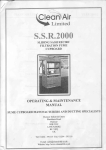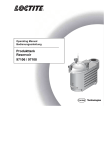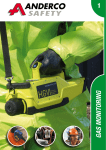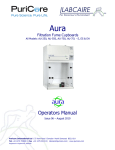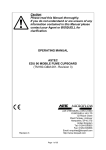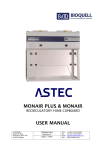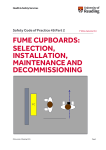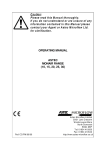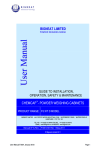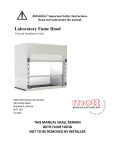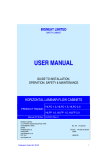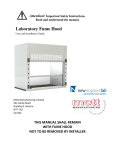Download SSR2000 O&M
Transcript
CLEAN AIR LTD SSR2000 MOBILE FILTRATION FUME CUPBOARD OPERATING, MAINTENANCE & SERVICE MANUAL CONTENTS Page No. Introduction 1 Operating Instructions 2 Performance & Safety 4 Control Membrane 6 Filters 7 Maintenance 9 PAT Testing 10 Warranty 11 Fume Cupboard Details, Filters & Service Record 12 INTRODUCTION The SSR2000 is part of Clean Air’s commitment to protecting people and the environment. Clean Air is a quality company which occupies a significant part of the prestige section of the Fume Cupboard market. The SSR2000 underlines the investment Clean Air continually makes in research and development. This Fume Cupboard incorporates all the features of a sliding sash unit with the benefits of carbon filtration. Using carbon filters ensures the fumes are rendered harmless creating a safe working environment. The SSR2000 Fume Cupboard gives operator safety with excellent visibility, it operates at a very low noise level (50dBa) and because it re-circulates it does not expel expensive conditioned heated air. The Fume Cupboard is designed to keep fumes within the cabinet and isolated from the operator. The contaminated air is passed through a carbon filter to remove hazardous fumes, vapour or particles. The carbon filter is designed to absorb efficiently at a face velocity of plus 0.3 m/sec up to 0.5/sec at a sash opening of 400mm. The Fume Cupboard has been designed to conform to the following standards:BS EN14175 BS7258 parts 1 & 4 BS7989: 2001 Building Bulletin 88 Schools Science Service The Fume Cupboard has also been independently tested by:S.S.E.R.C. – Scotland C.L.E.A.P.S.S. – England and Wales. Page 1 OPERATING INSTRUCTIONS Note – The Fume Cupboard must only be operated with the correct type of filters and correctly installed. SWITCHING ON 1) Ensure the gas, water valves are in the off position and the light and fan switch are in the off position. 2) Ensure the sash is set to the correct working height for operation (i.e. 400 mm opening) and that sash stops are in the ‘Locked’ position. 3) Connect the gas, water, waste, plug & restraining cable into the docking station. 4) Start by depressing the light & fan switch on the front of the Fume Cupboard. 5) During the 20 or 30 seconds it takes the fan to build up speed and reach the correct volume, the airflow failure light will be in an alarm condition, proving the correct function of the warning device. 6) Once the system is working to the correct volume, the green indicator will illuminate, and the Fume Cupboard is now ready for use. SWITCHING OFF 1) If any liquids have been passed through the dripcup, switch on the water for a short period to rinse the waste system. 2) Switch off the system by depressing the fan switch will shut down the extract fan. After pressing the switch, the red air fail indicator will illuminate. 3) Ensure the gas, water valves are in the off position and the light is switched off. 4) Disconnect the gas, water, waste, plug & restraining cable from the docking station. Page 2 WORKING IN THE FUME CUPBOARD The fume cupboards are designed to have a face velocity of between 0.3 m/second 0.5 m/second at a sash opening of 400 mm (measured from the top of the aerofoil cill to the underside of the sash handle). In order to load the fume cupboard with equipment, it is necessary to raise the sash to the highest limits of sash travel. Once the fume cupboard loading has been completed, the sash must be lowered to ensure operator safety. The open aperture of the fume cupboard should not be obscured with equipment: it is recommended that 100 mm of space be left at the front of the work surface. This is to ensure that the flow through the open sash is not made turbulent, with a consequential loss of containment. Care should be taken not to block the air purge gap situated under the aerofoil cill at the front of the work surface. The operator of the fume cupboard should appreciate that when using hands and arms within the fume cupboard, all movements are to be slow, so that toxic fumes are not entrained in the wake of the moving limbs as they are withdrawn from the interior of the fume chamber. Similarly, when moving away from, or passing the face of an operating fume cupboard, all movement is to be restrained. The fume cupboard sash should be at the minimum opening to reduce the input air to a safe minimum; however, the clearing rate of the fume cupboard is increased if the sash is lowered. This technique should be employed if the reaction is known to involve rapid rates of release of toxic fumes. Page 3 PERFORMANCE & SAFETY To ensure maximum performance and operator safety the following points should be followed:Sash stops should be kept in the locked position so that the sash opening is kept at the working height of 400mm. It should not be operated with the sash in the fully opened position. The extraction fan should be turned off when not in use. The back baffle should have no obstruction behind the baffle, or blocking the lower slot opening. Spring loaded adjustment screws in the sash guide track can be turned in or out to vary the grip of the guide on the sash. This allows the sash to slide freely, and also takes up wear. Any chemicals stored in the fume cupboard should be in covered containers or capped bottles. Equipment used should be placed inside the working area before start-up, to prevent fume escape caused by movements in the chamber. Do not overload with equipment or materials as this will cause airflow disturbances. The Fume Cupboard must only be operated with the correct filter installed. Check the airflow and filter saturation on a regular basis. The face velocity at the working aperture (and therefore containment of fumes) is at a maximum with the sash at 400mm from the worktop. Bunsen burners or other heat source should not be placed too close (150mm) to the side or back panels. Filter blocks do not absorb carbon monoxide or hydrogen. However, small quantities (such as used in schools) will not present a hazard because of the large dilution factor from the airflow through the fume cupboard, and retardation of the chemical in the filter. The Fume Cupboards are designed to handle fumes and vapours given off during normal laboratory procedures. Page 4 The Fume Cupboard’s carbon filter can only process a very limited amount of smoke. Experiments which typically produce large quantities of smoke (Screaming Jelly Baby for example) should be undertaken in a ducted to atmosphere type Fume Cupboard. Always keep a spare filter and pack of pre-filters. High concentrations of fumes entering the filter block may temporarily reduce the filtration efficiency. For this reason any major spillage within the fume cupboard should be cleared up quickly. Following a major spillage, the pre filter must be changed. After stabilization the original filters can normally be re-used, provided saturation has not been reached. The Carbon Filter is specifically designed to absorb the fumes generated during GCSE and ‘A’ Level curriculum experiments. Page 5 CONTROL MEMBRANE Fan ON/OFF This will turn green when the fan unit is switched on and red when the fan is switched off. Hours Run Meter (Filter) This indicates the total number of hours running time for the filter. Low Airflow Alarm The alarm is the red light at the front of the unit. In normal operation, the red light will not light up. In the event of air-flow failure the red light will show and the alarm will sound in normal operation the green light will illuminate. If the red indicator lamp starts to flash on intermittently or stays on, the pre-filter is starting to block with dust and an airflow reading should be taken at the aperture to determine if the pre-filter needs changing. We advise changing the pre-filter if an airflow of 0.3m/sec cannot be maintained. Page 6 FILTERS Pre Filter The pre-filter is manufactured from a high performance material designed to remove particulates from the airstream. The filter material is based on electrets, which are permanently charged dielectrics. They remove particulates from the air by electrostatic forces generated by the fibers of the material. Over time and use the pre-filters will become blocked, and the airflow will be reduced at the Fume Cupboard aperture. The Fume Cupboard is fitted with a low airflow alarm. Refer to maintenance section and the performance & Safety section for further information. Main Carbon Filter The main carbon filter has be specially design and manufactured from different carbon grades to absorb the normal range of chemical fumes generated in Schools during GCSE and A level science, advised by CLEAPPS. The next page lists the chemicals that can be used in normal school experiments and which will be absorbed by the active carbon filter. Over time and use the carbon filters will become saturated, and will cease to remove the fumes effectively. Refer to maintenance section and the performance & Safety section for further information. Page 7 The activated charcoal filter will absorb substances used in normal school experiments. ORGANIC INORGANIC aluminium chloride & bromide ammonia ammonium chloride fumes bromine chlorine chromium (vl) dichloride dioxide (chromyl chloride) hydrogen acid vapour hydrogen sulphide iodine iodine chlorides lead fumes lead bromide fumes mercury and its compound nitric acid vapour nitrogen oxides (acidic) phospine phosphorous chlorides & bromides phosphorous oxides silicon tetrachloride sulphur chloride sulphur dioxide thionyl chloride tin (iv) chloride titanium tetrachloride zinc chloride fumes acid amides acid anhydrides acid chlorides acid nitrogen oxide alcohols aldehydes aliphatic amines & their salts aliphatic hydrocarbons aromatic amines & aromatic hydrocarbons aromatic nitro compounds carboxylic acids esters ethers ketones nitriles organo halogens phenols pyridine SMOKE ETC fine particles aerosols mists smoke dust CAUTION Please note that the following are specifically excluded from the lists:1. 2. 3. 4. Hydrogen Carbon Monoxide Nitrous Oxide Methane Page 8 MAINTENANCE Fume Cupboard maintenance should only be carried out be competent, trained and authorized persons. Before carrying out any maintenance work ensure all mechanical and electrical services are properly isolated, and it is chemically safe to proceed. RECOMMENDED ROUTINE MAINTENANCE. Monthly Please ensure the following is completed on a monthly basis:1. Clean down inner cabinet and base. 2. Clean down outer surfaces with mild disinfectant cleaner. 3. Clean sealant around drip cups/sinks/wastes. 4. Clean glass using glass cleaner. 5. Check service valves and outlets for leaks or damage. 6. Check condition of Pre-Filter. Six Monthly Please ensure the following is completed on a six monthly basis:1. Remove and clean the back baffle. Clean the rear of the chamber. 2. Wash all the interior surface of the chamber with diluted detergent. 3. Replace Pre-Filter. Annually The Control of Substances Hazardous to Health Regulations 1988 require that all measures provided for the control of exposure to substances hazardous to health are maintained in an efficient state in efficient working order and in good repair. The regulations also require the thorough examination and testing of local exhaust systems at least every 14 calendar months. Using fully trained and dedicated engineers, Clean Air offers a 12 monthly fully comprehensive maintenance service. Operator safety is our utmost priority and listed below are examples of the checks that are carried out during our maintenance visit to ensure that each fume cupboard, fume extract system and fan are completely fit for purpose. Page 9 PAT TESTING The SSR unit is a mobile product connected electrically via a trailing cord and 13Amp UK style 3 pin plug to a 230VAC UK mains socket outlet. The unit is a Class 1 appliance and should be periodically tested as a portable appliance. The SSR unit is electrically tested prior to leaving the factory and would not normally require further testing for 12 months’ from the date of purchase, unless the customer’s test regime dictates otherwise. The socket outlet on the front of this unit is protected by an integral 30mA RCD. This RCD should not be subjected to the insulation test during Portable Appliance Testing (PAT) otherwise damage may be caused to the device. Damage caused by such testing is not covered by the manufacturer’s warranty. In order to conduct a Class 1 appliance test, the RCD socket front should be disconnected. The correct procedure to do this is described below. CAUTION – this procedure should be carried out only by persons suitably trained and competent in Portable Appliance Testing. Disconnect the SSR unit from the mains supply (Removal of the 13A UK style 3 pin plug from the mains socket – NOT just turning the socket off at the switch). Unplug any appliances which may be connected to the RCD socket front on the SSR unit itself. Unscrew the RCD socket front from the SSR unit itself. Disconnect all 3 conductors (line – brown, neutral – blue, cpc – green/yellow). Connect the same 3 conductors in step 4 above into three terminal strip connectors (or other suitably insulated connection box) ensuring the conductors are kept separate from each other i.e. not connected together. Ensure none of the conductors are touching each other or the chasis of the SSR unit. Ensure prior to testing that personnel will not come into contact with the SSR unit during testing (PAT voltages can be hazardous). Perform standard Class 1 appliance test. Disconnect portable appliance tester. Reinstate the RCD socket front by reversing the procedure in steps 5, 4 & 3 above. When mains power is applied to the SSR unit following portable appliance testing, the functional test buttons on the RCD socket front should be tested for correct operation. The test button should trip the power to the RCD socket front and the reset button should reinstate the power to the RCD socket front. A separate RCD ramp test to determine trip current and trip time should be conducted. Ensure perform is within parameters (as per BS7671:2008). If the SSR unit fails any of the Class 1 appliance tests or the RCD functional/ramp tests, the unit should be removed from service and reported accordingly. Page 10 WARRANTY Clean Air Ltd products are warranted under normal usage for one-year parts and labour costs, from the date of purchase. The warranty operates providing the following conditions are met: The product has been installed and used as stated within the instruction manual. The warranty does not include servicing or maintenance. Failure to maintain or service this product will invalidate the warranty. Maintenance must be carried out in accordance with the service manual and within the stated periods. Failure to use approved service companies or Clean Air Ltd. personnel also affect the CE marketing status of the product, removing Clean Air Ltd’s duty of care and responsibility. Supplies used such as cleaning solutions, disinfectants, are not covered by this warranty. Carbon filters, pre-filters, light tubes are not covered by this warranty. The warranty is void is faults are caused by accidental damage, mishandling by unauthorised personnel or failure to follow the correct maintenance and safety precautions in the instruction manual. The warranty is the sole warranty provided in connection with the product and no other warranty, expressed or implied, is provided. Clean Air Ltd. assumes no responsibility for any other claims, consequential loss (including lost time or profit) or other damage, whether based in contract, tort or otherwise, not specifically stated in this warranty. The seller shall not be liable to the buyer by reason of any representation (unless fraudulent), or any implied warranty, condition or other term, or any duty at common law, or under the express terms of the contract for any loss of profit or any indirect, special or consequential loss, damage, costs, expenses or other claims (whether caused by the negligence of the seller, it’s servants or agents or otherwise) which arise out of or in connection with the supply of the goods or their use or resale by the buyer, and the entire liability of seller under or in connection with the contract shall not exceed the price of the goods. If the warranty period has expired and you are having problems with the Fume Cupboard then please do not hesitate to contact us for advice or to arrange for an engineer to visit and repair the fault (This would be chargeable). Page 11 FUME CUPBOARD DETAILS Product details have been listed below, please fill in any blanks. Model SSR2000 Serial No. Location Date of Purchase FILTER DETAILS Please use this table as a record for the changing of the filters. Filter Type (Carbon or Pre-Filter) Date Changed Next Change Due Changed By SERVICE DETAILS Please use this table as a record of the servicing of the Fume Cupboard. Date of Service Serviced By (Company Name) Page 12 Next Service Due Date Clean Air Ltd Dunscar Business Park Blackburn Road Dunscar Bolton BL7 9PQ United Kingdom Tel: +44 (0) 1204 591115 Fax: +44 (0) 1204 591116 E-mail: [email protected] Website: http://www.cleanairltd.co.uk















